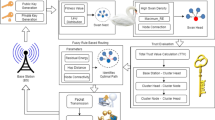Abstract
Wireless sensor networks (WSNs) have conquered comprehensive survey progressions in the regular control and management fields. Although WSN allows the spatial monitoring of real-world events, the mobility action depletes a huge part of a sensor’s energy cost in wireless communication. WSN sensors are often prone to various faults as frequent crashes and temporary or permanent failures. This is because it propagates them in very complex and harsh environments. So, we tend to design a Self-Adaptive based Autonomous Fault-Awareness (SAAFA) model, to limit the impact of such failures and filter them. In this paper, we incorporate the two of adaptive-filters FIR with RLS through three adaptive two-stages performed at the level of cluster head, for independent fault-correction during the propagation platform. The proposed model (SAAFA) included two stages, the first stage comprised self-detection the failure and self-aware for the lost scales, in which relied on responses of delay port and prior-knowledge of absent sensor-signals throughout monitoring, through adjusting the filter weights in the adaptive feedback loop for awarding convergent signals for the lost ones. The second stage is adaptive filtering the registered signals from the above stage for gaining pure measures and free of interferences. Compared to the state-of-the-art methods, the scheduled model attained a speed in diagnosing faults and awareness the missing readings with a rate of accuracy reached 98.8% improving the robustness of performance. Evaluation criteria revealed the progress of SAAFA in reducing the radio communication to ~ 97.47% that kept about 93.7% of battery-energy throughout the picked dataset sample. Hence, it expanded the whole network lifetime.






Similar content being viewed by others
References
Shylaja, S., & Muralidharan, R. (2017). Application of data mining techniques in wireless sensor networks: Review. IRACST—International Journal of Computer Networks and Wireless Communications, 7(3), 1–5.
Malik, N., & Kumar, P. (2017). Distributed data mining in wireless sensor network using fuzzy naïve byes. International Journal of Engineering and Computer Science, 6(8), 22327–22332.
Jassbi, S. J., & Moridi, E. (2019). Fault tolerance and energy efficient clustering algorithm in wireless sensor networks: FTEC. Wireless Personal Communications, 107, 373–391. https://doi.org/10.1007/s11277-019-06281-6.
Elsayed, W. M., El-Bakry, H. M., & Salah, M. E. (2019). Data reduction using integrated adaptive filters for energy-efficient in the clusters of wireless sensor networks. IEEE Embedded Systems Letters, 11(4), 119–122. https://doi.org/10.1109/LES.2019.2902404.
Yuvaraja, M., & Sabrigiriraj, M. (2017). Fault detection and recovery scheme for routing and lifetime enhancement in WSN. Journal of Wireless Networks, 23, 267–277.
Cheng, Y., Liu, Q., Wang, J., Wan, S., & Umer, T. (2018). Distributed fault detection for wireless sensor networks based on support vector regression. Hindawi Wireless Communications and Mobile Computing, 2018(1), 1–9. https://doi.org/10.1155/2018/4349795.
Jia, S., Ma, L., & Qin, D. (2018). Fault detection modelling and analysis in a wireless sensor network. Hindawi Journal of Sensors, 2018(1), 1–10. https://doi.org/10.1155/2018/7935802.
Diwakaran, S., Carmalatta, J., Perumal, B., & Velmurugan, S. P. (2018). An energy efficient data prediction using adaptive step size for increasing network lifetime in wireless sensor networks. International Journal of Pure and Applied Mathematics, 118(18), 2571–2578.
Fathy, Y., Barnaghi, P., & Tafazolli, R. (2018). An adaptive method for data reduction in the internet of things. In IEEE 4th world forum on internet of things, Singapore, 5–8 February.
Masoum, A., Paul, J. M., & Nirvana, M. (2018). Less is more: Data reduction in wireless sensor networks. University of Twente. Enschede. 978-90-365-4564-8. Published 8 Jun 2018.
Zhu, P., Dong, W., Mao, Y., Shi, H., & Ma, X. (2019). Kernel adaptive filtering multiple-model actuator fault diagnostic for multi-effectors aircraft. In 2019 12th Asian control conference (ASCC) Kitakyusyu international conference center, Japan, June 9–12, 2019.
Zhong, Y., Zhang, W., Zhang, Y., Zuo, J., & Zhan, H. (2019). Sensor fault detection and diagnosis for an unmanned quadrotor helicopter. Journal of Intelligent & Robotic Systems, 96(3–4), 555–572. https://doi.org/10.1007/s10846-019-01002-4.
Javaid, A., Javaid, N., Wadud, Z., Saba, T., et al. (2019). Machine learning algorithms and fault detection for improved belief function based decision fusion in wireless sensor networks. Sensors Journal, 19(6), 13–34.
Yarinezhad, R., & Hashemi, S. N. (2019). Distributed faulty node detection and recovery scheme for wireless sensor networks using cellular learning automata. Journal of Wireless Networks, 25, 2901–2917.
Bae, J., Lee, M., & Shin, C. (2019). A data-based fault-detection model for wireless sensor networks. Sustainability Journal, 11(6171), 1–15. https://doi.org/10.3390/su11216171.
Moussa, N., El Alaoui, A. E., & Chaudet, C. (2020). A novel approach of WSN routing protocols comparison for forest fire detection. Journal of Wireless Networks, 26, 1857–1867.
Saraswathi, S., Suresh, G. R., & Katiravan, J. (2020). False alarm detection using dynamic threshold in medical wireless sensor networks. Journal of Wireless Networks. https://doi.org/10.1007/s11276-019-02197-y.
Author information
Authors and Affiliations
Corresponding author
Ethics declarations
Conflict of interest
On behalf of all authors, the corresponding author states that there is no conflict of interest.
Additional information
Publisher's Note
Springer Nature remains neutral with regard to jurisdictional claims in published maps and institutional affiliations.
Rights and permissions
About this article
Cite this article
Elsayed, W.M., El-Bakry, H.M. & El-Sayed, S.M. An Autonomous Fault-Awareness model adapted for upgrade performance in clusters of homogeneous wireless sensor networks. Wireless Netw 26, 5085–5100 (2020). https://doi.org/10.1007/s11276-020-02381-5
Published:
Issue Date:
DOI: https://doi.org/10.1007/s11276-020-02381-5




